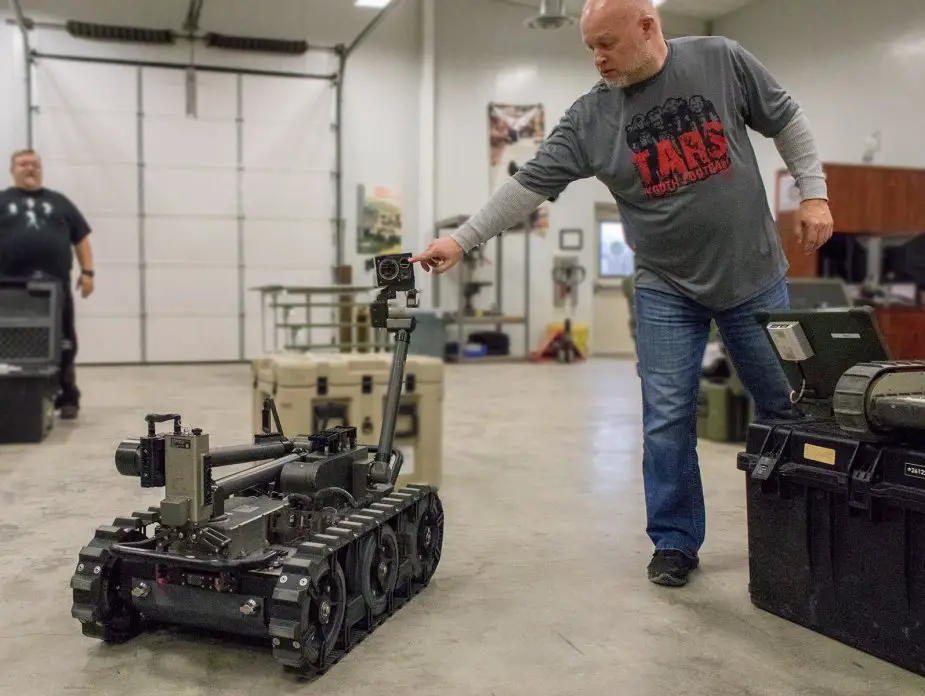Ft. Leonard Wood Robotics University develops new robot to be used by all services
The Robotics University at Fort Leonard Wood, Training Area 211, is ready to field a new robot -- the Man Transportation Robotic System Increment II (MTRS Inc II) -- to be used by the Army, Air Force, Marines and Navy for multiple purposes, including explosive ordnance disposal and detection of chemical, biological, radiological and nuclear hazards. Sam Campbell reports.

Bill Hagerty, Robotics University new equipment trainer, points to the new thermal vision camera atop the MTRS Inc II robot. The robot will soon replace its predecessor, the Talon 5, and boasts an array of improvements. (Picture source: Sam Campbell)
According to the U.S. Army Acquisition Support Center, "The MTRS Inc II provides the warfighter with an ability to locate, identify and clear landmines, unexploded ordnance and improvised explosive devices in the path of maneuvering forces. It also provides CBRN Soldiers with the capability to employ CBRN sensors from a distance."
Officials said the robot is finished with preliminary development and is scheduled to be fielded in February 2020 with a unit at Fort Belvoir, Virginia. According to Dwayne Resch, new equipment training manager, officials in the acquisition community have been pushing to standardize robotics hardware across the entire military -- and the MTRS could be the answer to that call. "This is probably the first robot that has crossed over to every branch," he said. "It keeps the cost down." He said it can be configured differently depending on a unit's needs, only requiring minimal changes.
Beyond minimizing financial burdens, the 156-pound MTRS Inc II boasts an impressive array of improvements from its predecessor, the Talon 5, Robotics University officials said. The robot's radio system is used not just for communication, but to transmit live streams of video and data, which requires large bandwidth due to huge file size. Matt Resch, robotics technician, said the radio can handle that and more: "The radio has really improved quite a bit," he said. "We're barely touching the capabilities. The way you can program it, and how much stuff you can do inside that is amazing." The MTRS Inc II also features a thermal camera and more degrees of movement for its mechanical arm than its predecessor, allowing the arm to turn horizontally without rotating the entire machine.
Training and operation of the machine have taken cues from a popular form of entertainment among the younger population -- video games. "Almost every robot now is (coming) standardized with a PlayStation controller or an Xbox controller, trying to get the mindset of these young Soldiers coming in," the technician said. He said the community is "getting rid of the old suitcase-style controllers they had."
Chris McDonald, a senior instructional design specialist with Intelligent Decision Systems Inc., is working with the Robotics University on an actual video game where Soldiers are trained on how to operate the robot.
The game is slated to be an official part of the MTRS Inc II training course curriculum. "It's developed like a first-person (perspective), so you're behind the controller of the robot," he said. "There's skyline, there's trees, there's birds singing, there's tracks. We have a whole team of game developers on it that are trying to make it as close to something you (would play) on a (console)."
Officials said the benefit of this type of training is that Soldiers can do it anywhere, even from the comfort of their own home: "You'll be able to sit back, maybe at midnight when you're normally playing 'Call of Duty,' (and say) 'let me knock this out,'" McDonald said. "This is interactive and it's fairly fun."
The Robotics University has a 12-year history at Fort Leonard Wood. It repairs every single EOD robot in the entire Army. University officials said if units find themselves with an MTRS Inc II machine in need of repairs, they can fix it, and fix it fast. The technician said typical turnaround is only a matter of days. "We diagnose the problems they're having and repair them and ship them back to the Soldiers," Matt Resch said. "From ship to ship date is roughly about two weeks."
The university was given its title because it is a "one-stop shop" for all things robotics, Dwayne Resch said.


























